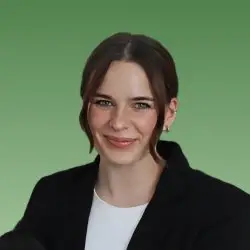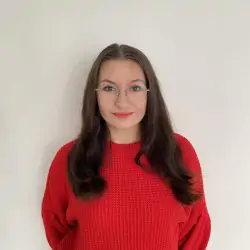How to Do a Brand Audit? The 10-Step Guide [2026]
Table of contents
Even 4 out of 5 consumers say they won’t buy from a brand they don’t trust. In other words, trust isn’t a nice-to-have – it’s the fuel that powers your brand growth. And just like with a car, the lower the quality of fuel you use, the higher the risk your engine will eventually break down. That’s why doing a regular brand audit is so essential – it helps your brand run smoothly, safely, and at full speed.
- A brand audit evaluates internal factors, external perception, and customer insights to reveal your current brand performance and find areas for improvement.
- Although a brand audit requires time and effort, it’s an incredibly powerful tool to keep your brand consistent, trustworthy, and competitive.
- Each brand audit should consist of a framework (that sets a purpose and a scope) and an action plan (that translates findings into concrete steps for improvement)
What is a brand audit?
A brand audit is a strategic analysis of how your brand currently performs in the market, what your strengths and weaknesses are, and how well your brand aligns with your business goals and customer expectations.
In a nutshell: a brand audit reveals how your brand performs and where it can be improved.
A comprehensive brand audit examines three key areas:
- Internal branding – evaluates company culture, brand values, mission, and how well employees understand & embody the brand.
It focuses on what’s inside the organization and whether your team understands and communicates the brand’s essence consistently. - External branding – analyzes how your brand appears across all touchpoints, encompassing visual identity, messaging, advertising, social media, PR, website content, and more.
It focuses on how your brand is seen from the outside and whether that image reflects your intended positioning and values. - Customer experience – assesses how people interact with and perceive your brand at every stage of the customer journey, including service quality, communication, product delivery, and post-sale services.
It focuses on how customers feel about your brand when they interact with it directly.

How to conduct a brand audit? 10 steps

Step 1: Define your framework
At the beginning, you need to understand the purpose of conducting a brand audit and define its scope.
In other words, you must identify which aspects of your brand you want to focus on – such as brand awareness, perception, consistency, or performance.
Regardless of your choice, establish a baseline. Clearly define where your brand currently stands using measurable goals, KPIs, and metrics.
In other words, you must put your cards on the table and check expectations vs. reality!
For example:
- When auditing brand awareness, your baseline could be the volume of monthly mentions or social media reach goals, KPIs, and metrics
- When auditing brand perception, your baseline could include sentiment analysis, customer satisfaction score (CSAT), or review ratings.
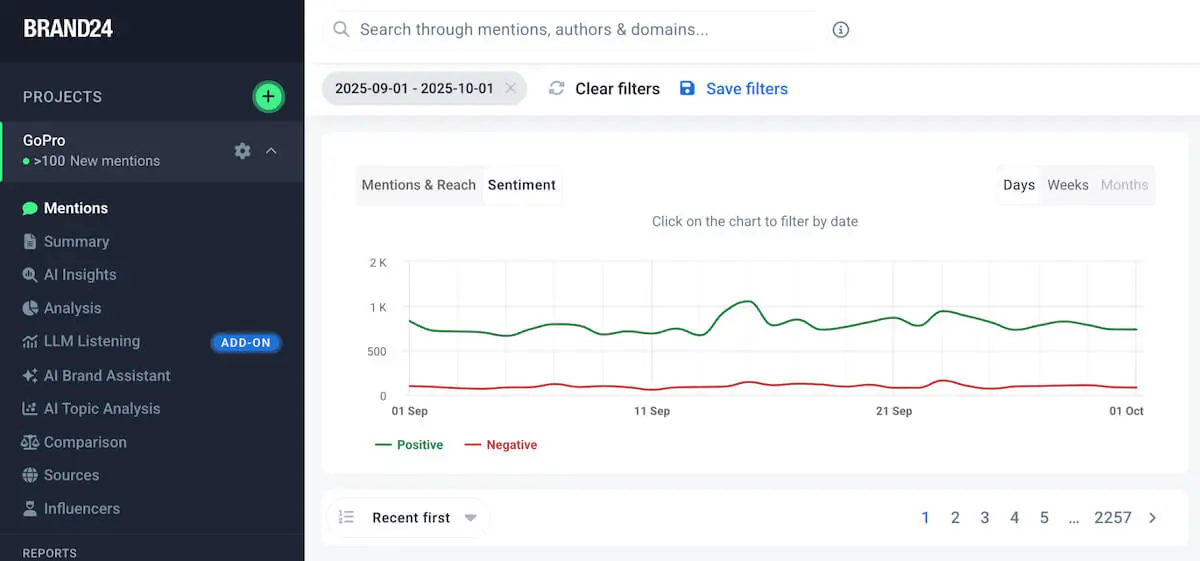
Step 2: Review your brand foundations
Before diving into data and design, take a closer look at the core elements defining your brand identity.
This step is about confirming if your foundational brand elements still reflect who you are, what’s important to you, and how you want to be perceived.

In practice, review your:
- Mission and vision statements. Do they still reflect your company’s purpose and long-term direction?
- Brand values. Are they clearly defined, consistent, well-communicated, and truly visible in your company culture?
- Unique value proposition (UVP). Does it clearly differentiate you from competitors and resonate with your audience?
- Brand personality. Is it aligned with your current positioning and customer expectations?
If you discover a gap between how you envision your brand and how others truly perceive it, it may be time to update your brand foundations.
Step 3: Evaluate internal branding
Your brand starts from within.
A strong internal branding ties your employees to the company’s values and mission, fostering a culture of trust, motivation, and productivity.
Evaluating internal branding involves communicating the brand’s story, creating initiatives that embody the brand in people’s lives, and ensuring that your team feels connected to the brand’s mission, values, and messaging.
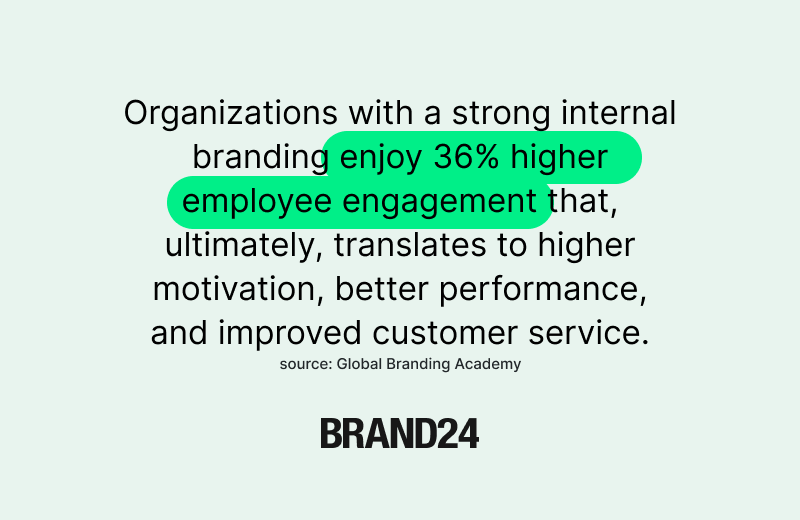
In practice, you can discover your internal branding through:
- Employee satisfaction surveys
- Internal communication audit
- Culture assessment
When done well, a strong internal branding strategy turns employees into powerful brand ambassadors, improves workflow, and boosts the brand’s reputation.
Step 4: Check your external branding
Now, turn your attention to the outside.
External branding means how a company presents itself to the public. It encompasses all the visible elements that are customer touchpoints – from your logo color palette to paid ads and public relations.
This step helps you determine whether your external image aligns with your intended positioning and how consistently your brand is presented across all channels.
Review:
- Visual identity. Is your logo, color palette, and typography used consistently across platforms?
- Messaging and tone. Does your communication sound like your brand across social media, your website, emails, and ads?
- Marketing materials. Are your visuals and messages consistent, recognizable, and up to date?
- Public relations and media presence. How is your brand presented in external articles, interviews, and partnerships?
If you discover inconsistencies or outdated elements, create a list of what needs to be refreshed or unified.
Step 5: Analyze website performance and SEO
Your website is often the first touchpoint between your brand and potential customers. Therefore, it plays a significant role in shaping how your brand is perceived.
A well-performing website not only reflects professionalism but also strengthens brand visibility, user trust, and conversions.
Analyze:
- Technical performance. Check site speed, mobile responsiveness, and loading times using tools like Google PageSpeed Insights or GTmetrix. Slow or unresponsive pages can harm both SEO and user experience.
- User experience (UX). Is your website intuitive, easy to navigate, and visually aligned with your brand identity? Are visitors finding the information they need quickly? You can use tools like Hotjar or Clarity.
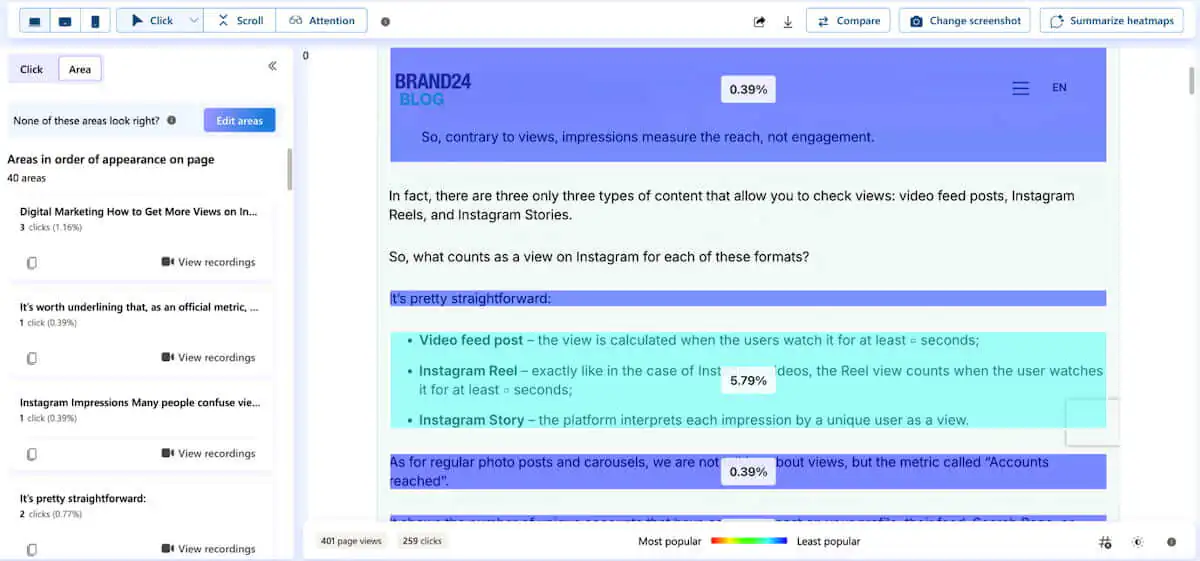
- Content quality. Review whether your website copy is clear, engaging, and consistent in tone. Does it reflect your brand’s voice and values?
- SEO performance. Use tools like Google Analytics or Semrush to check organic traffic, keyword rankings, and backlink quality. Identify which pages bring in the most traffic and which ones need optimization.
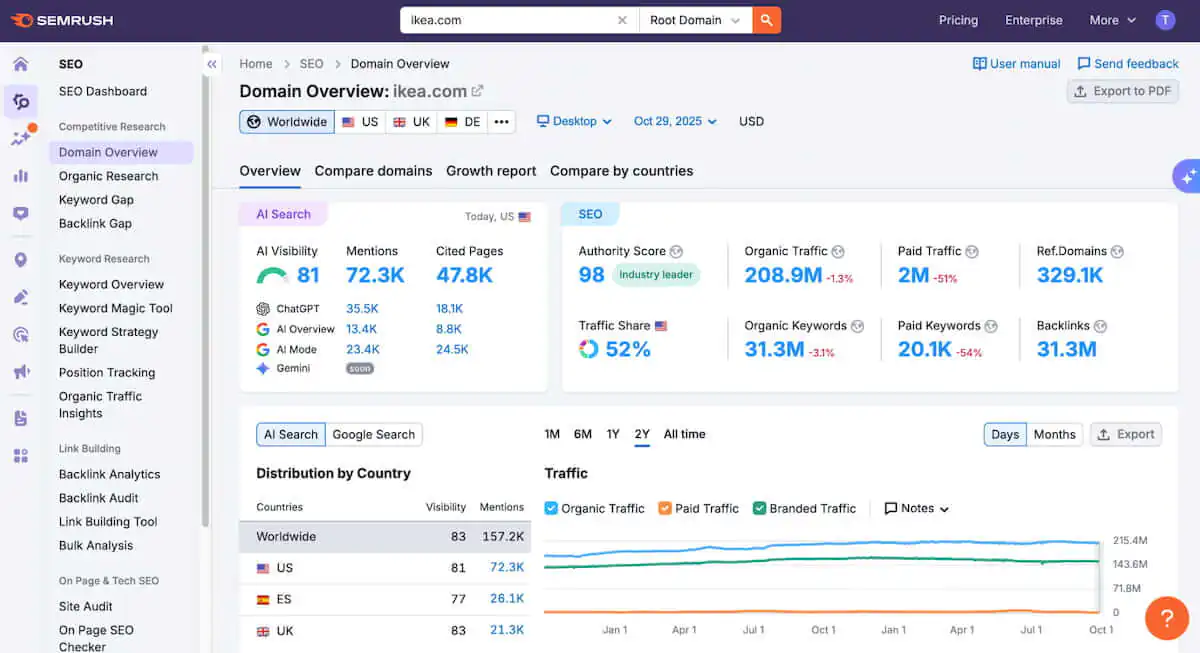
By identifying technical issues, UX bottlenecks, and SEO gaps, you can strengthen your online presence and ensure that your website truly supports your brand goals.
Step 6: Review social media and online presence
Social media channels are where your brand’s personality is most visible. They’re also places that shape customers’ opinions fast.
Therefore, no brand audit would be complete without checking whether your online presence reflects your brand accurately and effectively.
Analyze:
- Your performance on various social platforms. Not every social media platform gives you the same visibility and hype. Check which of them you should focus on. And which should you abandon.
- Content performance. Review engagement metrics such as likes, comments, shares, and click-through rates. Identify which content formats resonate with your audience.
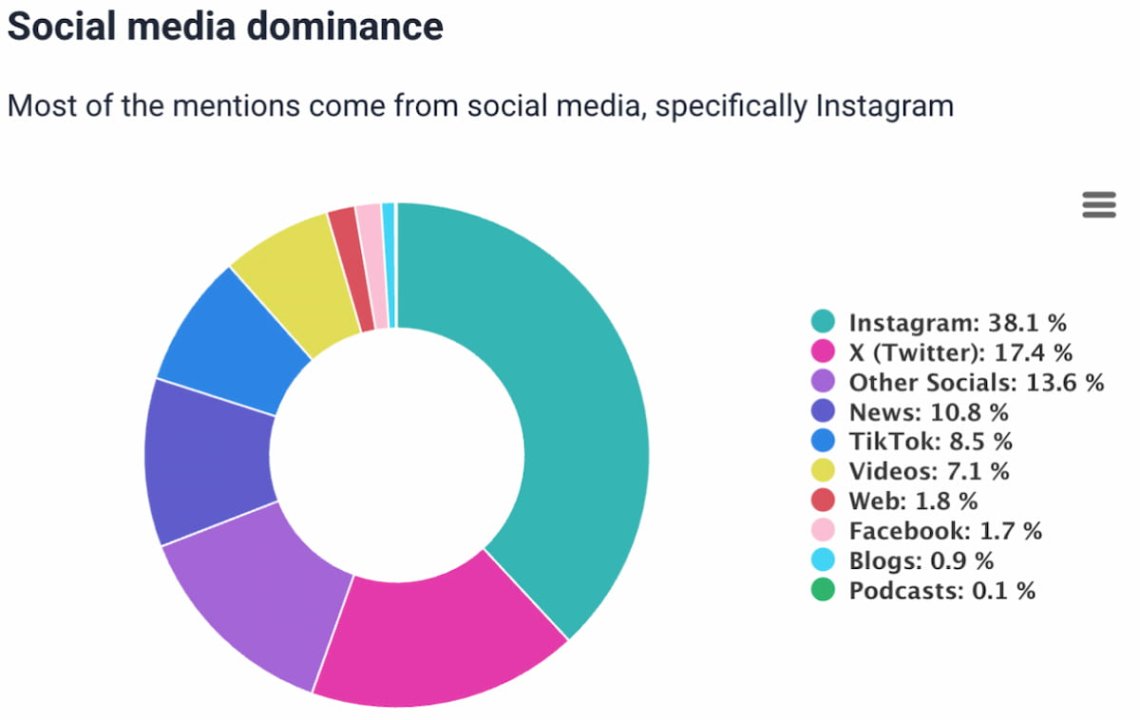
- Consistency. Check if your brand voice, tone, and visual identity are the same across all platforms you use (LinkedIn, Instagram, Facebook, X, TikTok, etc.)
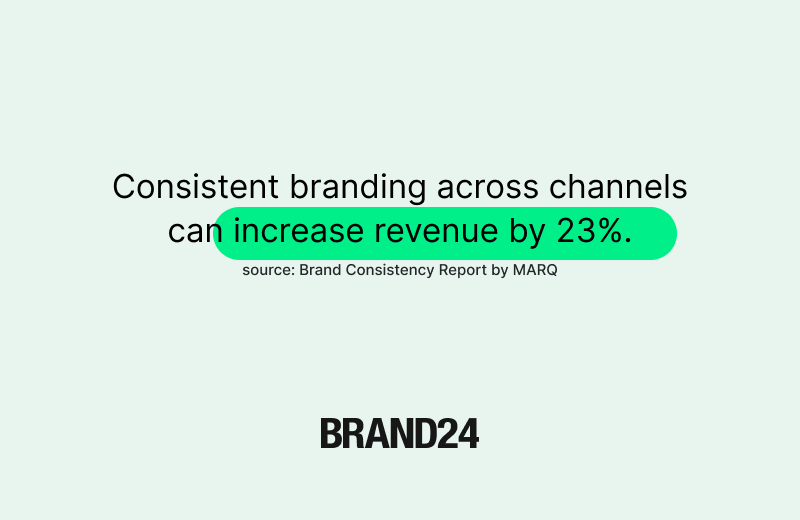
- Target audience. Are you reaching the right people, so those who match your target audience? Review follower demographics and behavior.
- Reputation and sentiment. Use social listening tools (like Brand24) to monitor mentions, hashtag performance, and sentiment around your brand. Look for recurring topics, trends, and influencers.

- Competitor comparison. Evaluate your social media performance, engagement, and messaging against key competitors.
Step 7: Check AI brand visibility
With the rise of generative AI tools, your brand visibility goes beyond traditional search engines and social media.
ChatGPT, Perplexity, Gemini, DeepSeek, AI Overview – all these tools are becoming increasingly important for brand discovery and reputation.
Therefore, monitoring your AI brand visibility is a crucial part of a modern brand audit.
Track:
- How AI tools describe your brand. Ask AI chatbots and Google what they know about your brand. Do they provide accurate, up-to-date, and positive information?
- Relevant prompts. AI visibility monitoring tools like Chatbeat allow you to track your brand’s positioning on multiple prompts that people use in LLMs and AI tools.
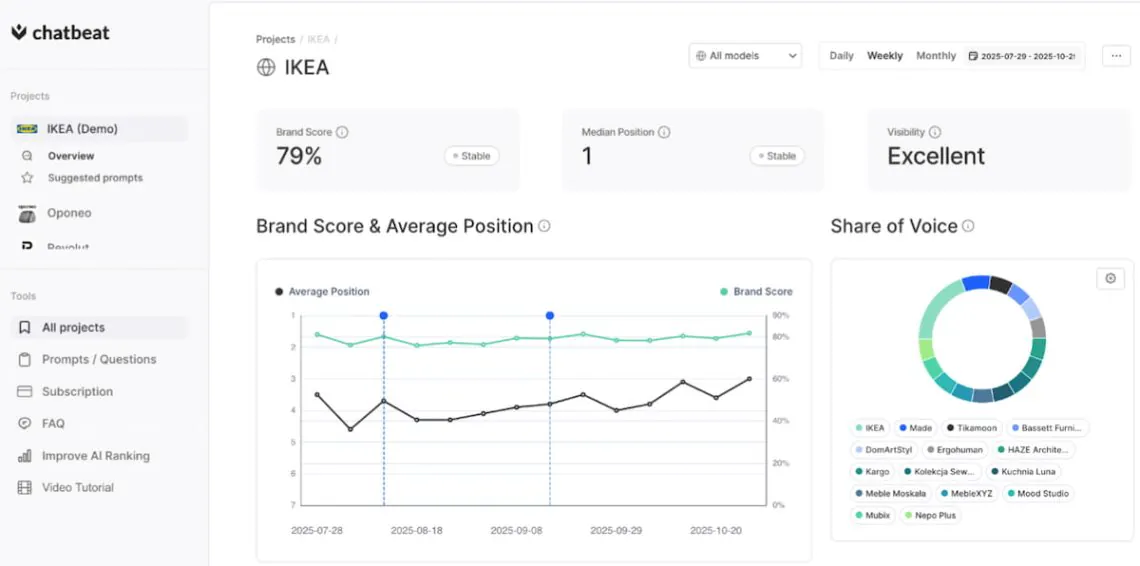
- Sources of data. Identify where AI models obtain their information about your brand (your website, Wikipedia, industry-specific outlets) and ensure these descriptions accurately reflect your brand.
Learn more: How to measure and maximize AI brand visibility?
Step 8: Gather customer insights
Your customers are the ultimate judges of your brand.
They completed the entire purchase process – from initial awareness to post-purchase experience – and can give you the most authentic feedback about your brand’s strengths and weaknesses.
In practice, gathering customer insights helps you understand how people perceive your brand, what they value most, and where the areas for improvement are.
Explore:
- Customer surveys and interviews. Ask questions about satisfaction and expectations.
- Online reviews and testimonials. Analyze what customers write on review platforms like Google, G2, TrustPilot, etc.
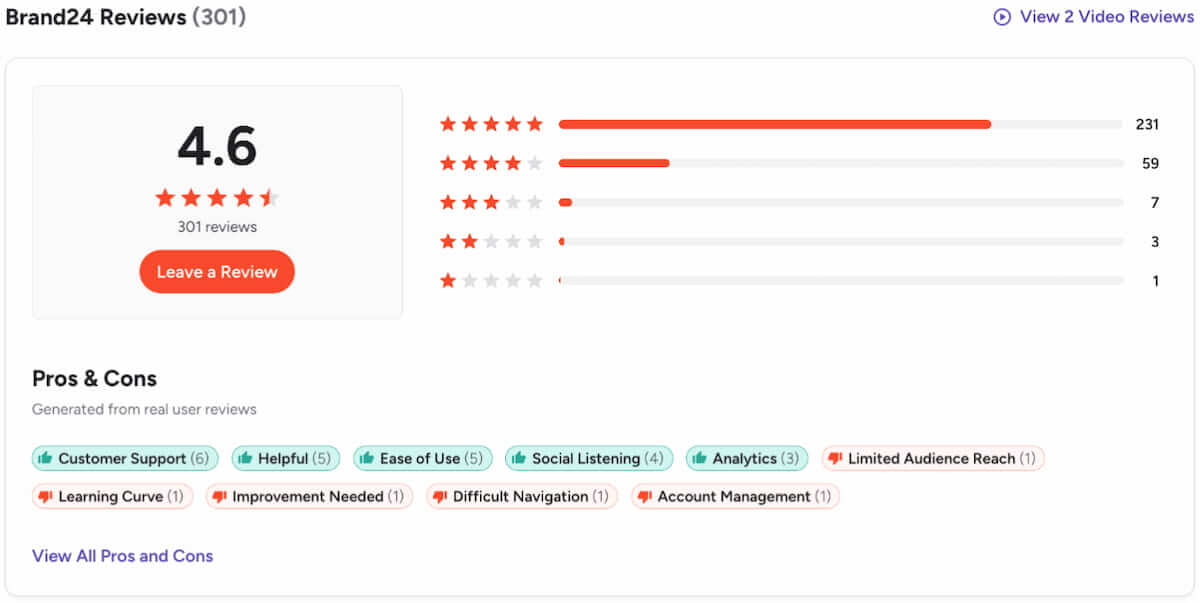
- Social listening. Use tools like Brand24 to monitor conversations and sentiment about your brand across multiple online platforms
- Customer service data. Review complaints, support tickets, and inquiries to identify pain points in the customer journey.
Customer feedback analysis is an invaluable source of data that can help you refine your brand experience, improve communication, and strengthen your brand reputation.
Learn more: Guide on customer feedback analysis
Step 9: Analyze sales and performance data
At the end of the day, your brand’s strength is reflected not only in awareness and perception but also in business results and performance metrics.
Analyzing your sales and marketing data helps you understand how effectively your brand converts attention into real, measurable outcomes.
In practice, focus on:
- Sales trends. Compare results over time to identify growth patterns and seasonal changes.
- Customer acquisition cost (CAC). Calculate how much you spend to attract a single customer. Rising acquisition costs may indicate a need for improvement.
- Conversion rates. Analyze how many leads turn into customers across different channels (website, ads, email, social media).
- Marketing ROI. Check which campaigns, channels, and activities bring the highest return on investment. This will help you identify where your spending pays off, and where resources are being wasted.
Further read: Most important brand metrics you should track
Step 10: Create an action plan and track progress
After gathering insights from all previous steps, it’s time to turn analysis into action!
A brand audit is valuable only if it leads to measurable improvements. And that’s where your action plan comes in.
Here’s what you should include in it:
- Key findings. Identify which issues and areas have the greatest impact on your brand’s performance and perception. Prioritize areas that influence customer trust, visibility, and revenue.
- SMART goals. Make sure each goal in your action plan is Specific, Measurable, Achievable, Relevant, and Time-bound. For example: “Increase positive sentiment share to 30% within 6 months”.
- Assign ownership. Decide who will be responsible for each task. Clear accountability builds action.
- Set a timeline. Establish milestones and deadlines to track progress.
- Define KPIs. Use measurable indicators and metrics to evaluate progress.
FAQ
Why conduct a brand audit?
At first glance, a brand audit might seem like an unnecessary process. The amount of data you need to analyze is huge, as you need to take a deeper look at different aspects of your brand presence, both off- and online.
But conducting an audit is necessary for building a strong brand because:
- Strong brands make more money and are more resilient to crises. A robust brand has higher brand awareness levels which directly translates into higher sales and lower churn.
- Brands with established positions in the market spend less money on attracting new customers. The rate of returning customers is also higher for healthy brands.
- People prefer brands they have a positive interaction with to over their friends and families.
All of the aspects mentioned above are elements of a healthy brand. All of them will increase your bottom line and help you conquer your target market. And the first step to a healthy brand is a brand audit.
What are the benefits of a brand audit?
A brand audit has many benefits:
- Provides data to measure and increase brand awareness, and possible tweaks you need to make
- Improves marketing communications tactics
- Provides guidelines for future brand development
- Grows the overall value of your company by implementing recommendations based on a robust set of data
- Gives insights into your brand positioning, brand architecture, and business structure
- Encourages a brand refresh, for example, through a new visual identity
- Detects the target audience’s thoughts and increases customer satisfaction
- Identifies a real, unique selling proposition and the brand’s strengths
